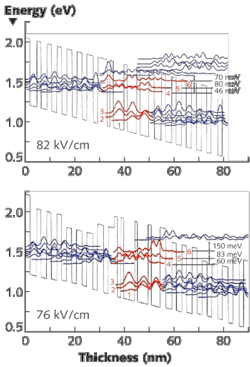SEMICONDUCTOR LASERS: Deep wells nearly double quantum-cascade-laser efficiency

Conventional quantum-cascade lasers (QCLs) have a core comprised of semiconductor quantum wells and barriers of fixed compositions; unfortunately, this construction causes carrier leakage in 4.5 to 5.5 µm mid-IR-emitting QCL devices that manifests itself as a rapid decrease in slope efficiency and a rapid increase in threshold-current density with temperature due to the small energy differential (approximately 200 meV) between the upper lasing level and the top of the exit barrier in each of the 30 to 40 active regions of the device core. And even though devices with buried heterostructures can have front-facet wall-plug-efficiency (WPE) values of 12% at room temperature, those devices are highly temperature sensitive and as a result are far from achieving their theoretical 28% WPE values.
Although many designs for alternative barrier and quantum-well structures devised to suppress carrier leakage were unsuccessful, a team from the University of Wisconsin-Madison (UWM) and the US Naval Research Laboratory (NRL; Washington, DC) has finally succeeded in developing an effective recipe.1, 2 By using deep-energy quantum wells and tall barriers, as well as carefully engineered relaxation and injection regions, carrier leakage from the active regions of these lasers is substantially suppressed such that both slope efficiency and threshold current vary with temperature half as fast as those in conventional QCLs. In turn, that should significantly increase the efficiency in continuous-wave (CW) operation and ultimately make long-term (that is, greater than 1000 hr) reliable watt-power-level CW QCLs a reality.
Deepening the well
The deep quantum wells in this new device require, for strain compensation, the aluminum (Al) content in the active regions to be increased significantly from 64% to 75%—creating much taller barriers. As a result the energy difference between the upper laser level and the top of the exit barrier increases to 450 meV; that is more than twice the value for conventional QCLs (see figure). Also compared to conventional QCLs, the relaxation region just beyond the active-region exit barrier has a tapered conduction-band edge. This pushes wavefunctions in the relaxation region away from the active region, minimizing overlap with the active region and further suppressing carrier leakage. Finally, the team also found that tapering the conduction-band edge of the injector region also reduces carrier leakage.
As expected, the characteristic temperature for the threshold-current density in the deep-well devices is increased to approximately 270K compared to just 140K for conventional QCLs over the operating temperature range 20–90°C. And the characteristic temperature for slope efficiency is increased from 140K to 285K. These high values for the characteristic temperatures indicate very strong suppression of carrier leakage. In addition the UWM-NRL team, in collaboration with a scientist from the Massachusetts Institute of Technology (MIT; Cambridge, MA), developed a theoretical model that estimates quite well the characteristic temperatures for both conventional and deep-well QCLs. It was also estimated that as a result of suppressing carrier leakage the CW WPE values for the front facet of 4.8 µm deep-well devices will increase to values in excess of 20%.
In addition to improving QCL WPE, suppression of carrier leakage means significantly better long-term operation at higher power levels. "Truly reliable QCL operation at watt-range CW powers becomes possible with this deep-well carrier suppression," says Dan Botez, Philip Dunham Reed professor at UWM. "Also, these new devices help realize mid-IR quantum-box [QB] lasers that hold the potential of room-temperature CW WPE values in excess of 50%." Such QB lasers could then be operated uncooled in handheld sensors for many mid-IR applications.3
REFERENCES
- D. Botez et al., Proc. SPIE 7616, 76160N (February 2010); http://dx.doi.org/10.1117/12.842593.
- J.C. Shin et al., Electron. Lett. 45, 741 (2009).
- D. Botez et al., Future Trends in Microelectronics: Unmapped Roads, eds. S. Luryi, J. Xu, and A. Zaslavksy, Wiley Interscience-IEEE Press, in press (2010).

Gail Overton | Senior Editor (2004-2020)
Gail has more than 30 years of engineering, marketing, product management, and editorial experience in the photonics and optical communications industry. Before joining the staff at Laser Focus World in 2004, she held many product management and product marketing roles in the fiber-optics industry, most notably at Hughes (El Segundo, CA), GTE Labs (Waltham, MA), Corning (Corning, NY), Photon Kinetics (Beaverton, OR), and Newport Corporation (Irvine, CA). During her marketing career, Gail published articles in WDM Solutions and Sensors magazine and traveled internationally to conduct product and sales training. Gail received her BS degree in physics, with an emphasis in optics, from San Diego State University in San Diego, CA in May 1986.